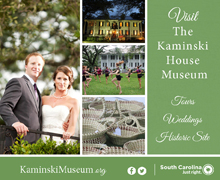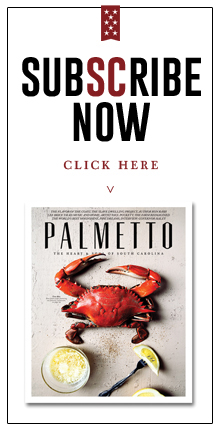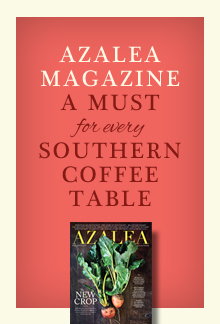
Historically Modern – The Dewberry
Charleston’s newest upscale boutique hotel is a modern expression of old Southern charm.
Few places can evoke a sense of nostalgia for days outside of one’s own lifetime or memory, but Charleston’s newest boutique hotel, The Dewberry, does just that. From the moment visitors are swept into the lobby through the revolving brass doors, The Dewberry beckons guests to grab an expertly crafted cocktail, relax into the plush couches, and live a life of midcentury modern luxury.
Situated adjacent to popular Marion Square, which plays host to regular festivals and weekly farmer’s markets, The Dewberry occupies the former L. Mendel Rivers Federal Building, which was occupied from 1964 until it was vacated in 1999 following damage from Hurricane Floyd. As a result of its nearly 15 year vacancy, many locals and newcomers have no prior connection to the location, and, given the period-specific style of its architecture, interior design, and furnishings, it is not much of a stretch to imagine that The Dewberry is simply a time capsule of a luxury hotel, perfectly preserved since the 1960s.
The reality, of course, is less romantic; the building was used for governmental offices, including the IRS, for over thirty years. After the hurricane of 1999, the building fell into disrepair, asbestos was rampant, and nobody touched the place for nearly a decade. In 2008, the property hit the auction block, where it was promptly scooped up by Atlanta-based Dewberry Capital, headed by former Georgia Tech quarterback John Dewberry.
Following the acquisition of the Meeting Street federal building, Dewberry and his team spent eight years painstakingly laboring over every detail in an effort to create a luxury hotel unlike any other. Starting with the necessary major projects, the team removed asbestos, cleaned the place up, knocked down unnecessary walls, and re-framed different spaces to reflect the needs of the hotel, including adding an entire seventh floor. Then came the more unusual projects, like bringing in the ground floor walls by about eight feet and leaving arched columns along the outer edge of the building to mirror the look of a Southern wrap-around porch.
Indeed, no element of the space fell outside of the discerning gaze of Dewberry, who revels in “getting it right,” in a stylistic and historically appropriate way. In every decision, Dewberry (and his fiance, Jaimie) sought to pay homage to the building’s 1960s roots, and the result is a 155-room hotel that feels like it is right out of the set of the popular AMC show “Mad Men,” complete with vintage furniture sourced internationally, locally produced art from the era, and even thoughtfully designed lighting and fixtures.
A visit to The Dewberry, whether for lodging, for a cocktail, or to dine at the on-site restaurant, Henrietta’s, begins with friendly valets, large brass doors, and the gleaming welcome of a mass of white marble, hand-selected by Dewberry and Brown in Danby, Vermont. Arriving street-side, a large, wall-mounted brass historical map of Charleston greets visitors near the concierge desk and Henrietta’s restaurant, while entering from the rear parking lot into “The Living Room” lounge area feels much like coming home.
The Living Room is smartly appointed with seating for any occasion: a conference-size table mingles elegantly with couches, highback chairs, and barstools. Danish modern bookcases frame the space, stacked appropriately with vintage books, plants, sculptures, and notions. A framed photo of John Dewberry’s father holds a place of honor next to the enormous brass bar, while hardwood floors reclaimed from a Virginia tobacco barn add warmth. Around the corner, toward Henrietta’s, two unique retail stores sit across from one another, filled with expertly curated goods. Named “Hunt” and “Gather,” the stores collectively form “Fieldshop,” which offers a range of Southern staples perfect for gifts.
As for Henrietta’s, the restaurant is a “French brasserie by foundation, southern by region,” serving up elevated versions of familiar, seasonally-appropriate dishes. With black and white tile floors, white tuxedoed wait staff, and floor to ceiling cafe windows, the environment is decidedly classic, and an excellent complement to the sophisticated hotel.
Upstairs, each of The Dewberry’s 155 guest rooms is as thoughtfully designed as its first floor. Featuring high quality linens and mattresses, marble bathrooms, and plush lounge areas, the rooms offer a quiet and unique respite from both the bustle of the city and mediocre lodging as a whole. Hand-selected spirits and snacks are on offer in the living area, while toiletries designed in-house are available for use in the bathroom. Impeccably styled with comfort in mind, the beautiful rooms are likely to find future guests sleeping in a bit longer than usual, if only to immerse themselves in the luxury for a few moments longer.
For larger gatherings, event spaces are at the ready, including “The Swanston Room,” the Ballroom, and the Walled Garden. The Swanston room, a reception area for up to 50 guests, features wall-to-wall avian-themed artwork by Atlanta-based artist Thomas Swanston. Warm lighting dances playfully off of the gold, silver, and platinum cranes within the art installation, lending a cozy atmosphere to the intimate space. Adjacent to “The Swanston Room”, a light-filled ballroom is perfect for dancing and its attached walled garden is sure to host many an unforgettable night in the future.
Walking around The Dewberry is an event in itself, a journey through time, textures, pleasantries, and beauty. As an exercise in paying homage to the past and the city seemingly lacking in much restraint, the entire property feels enveloped in opulence. In a city rich with history, culture, and cuisine, The Dewberry claims its place with equally graceful splendor.
By Jana Riley
Recommended
-
Q&A with Chris Jennings / Executive VP – Spartanburg CVBApril 17th, 2018
-
Music of the ForestApril 16th, 2018
-
Chairman of the BoardApril 16th, 2018
-
The Compass of a Community – Cooper’s Country StoreNovember 21st, 2017
-
History in the Making – Drayton HallNovember 21st, 2017








